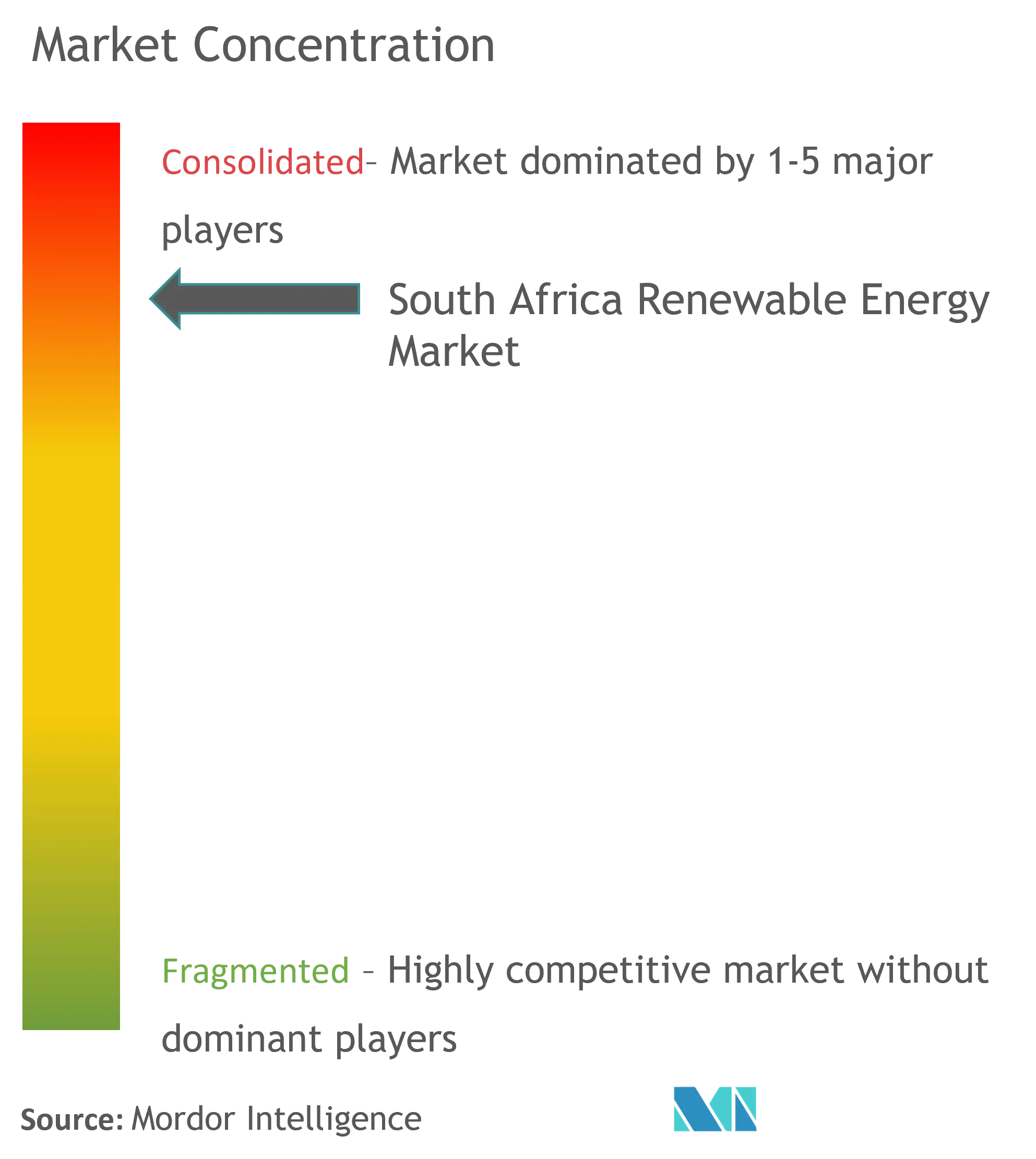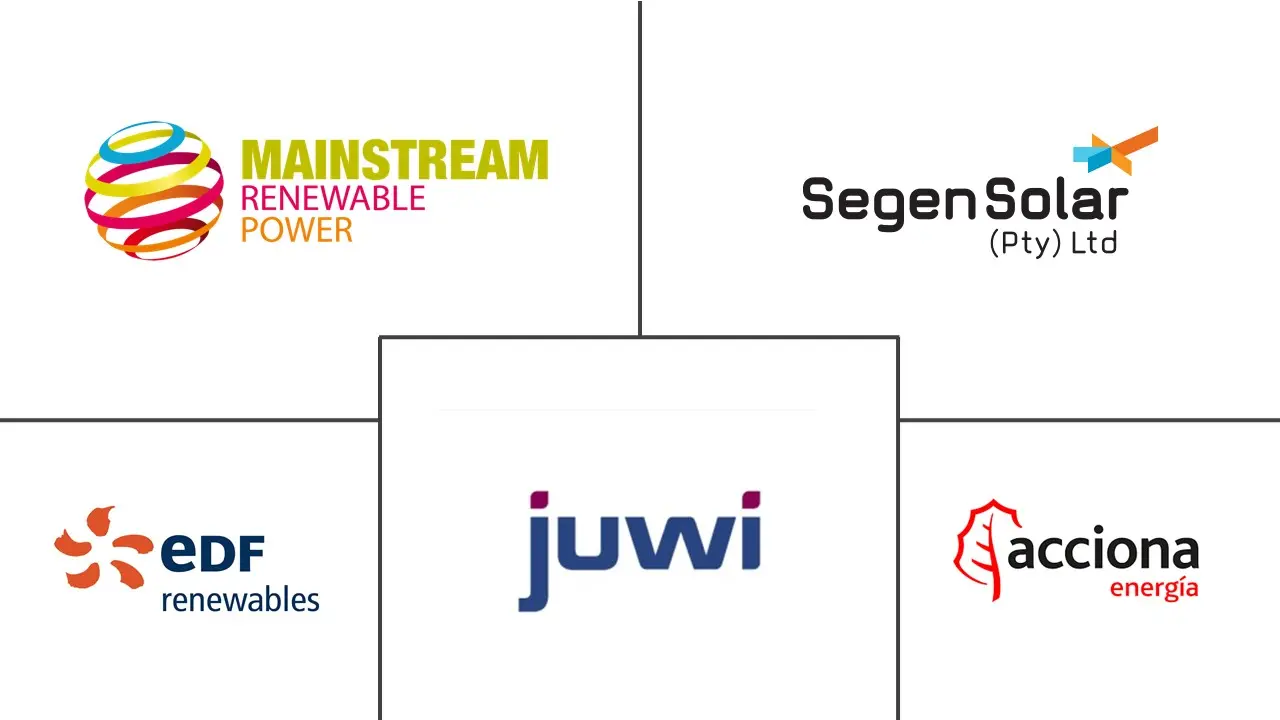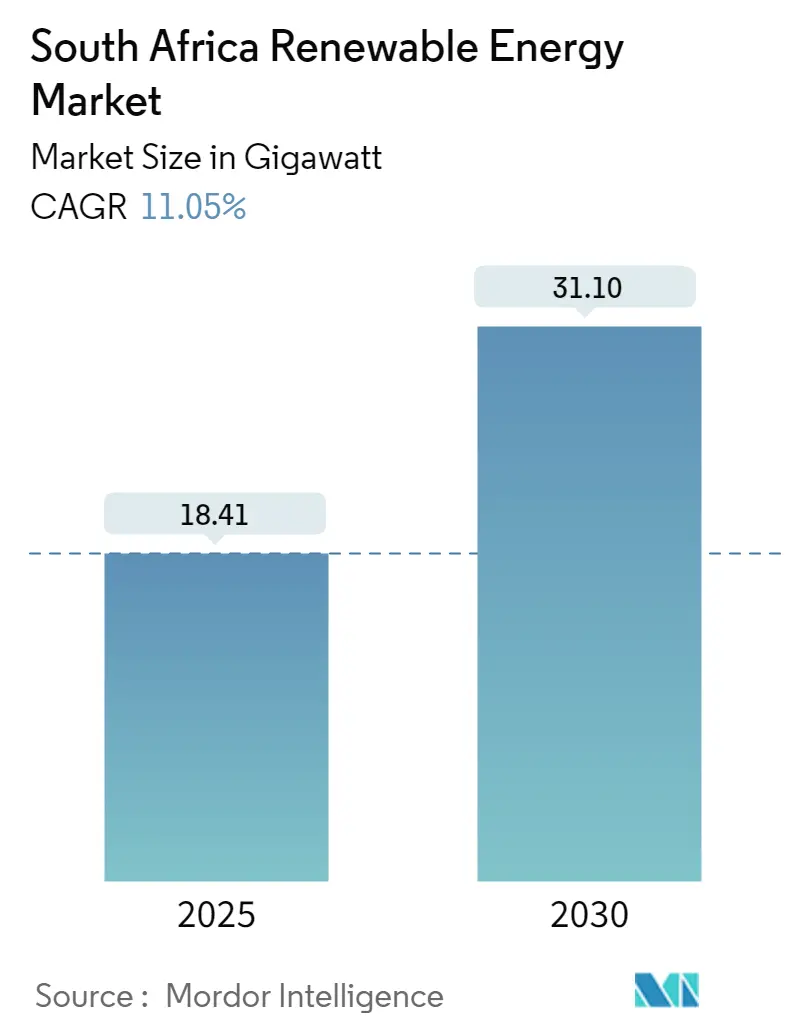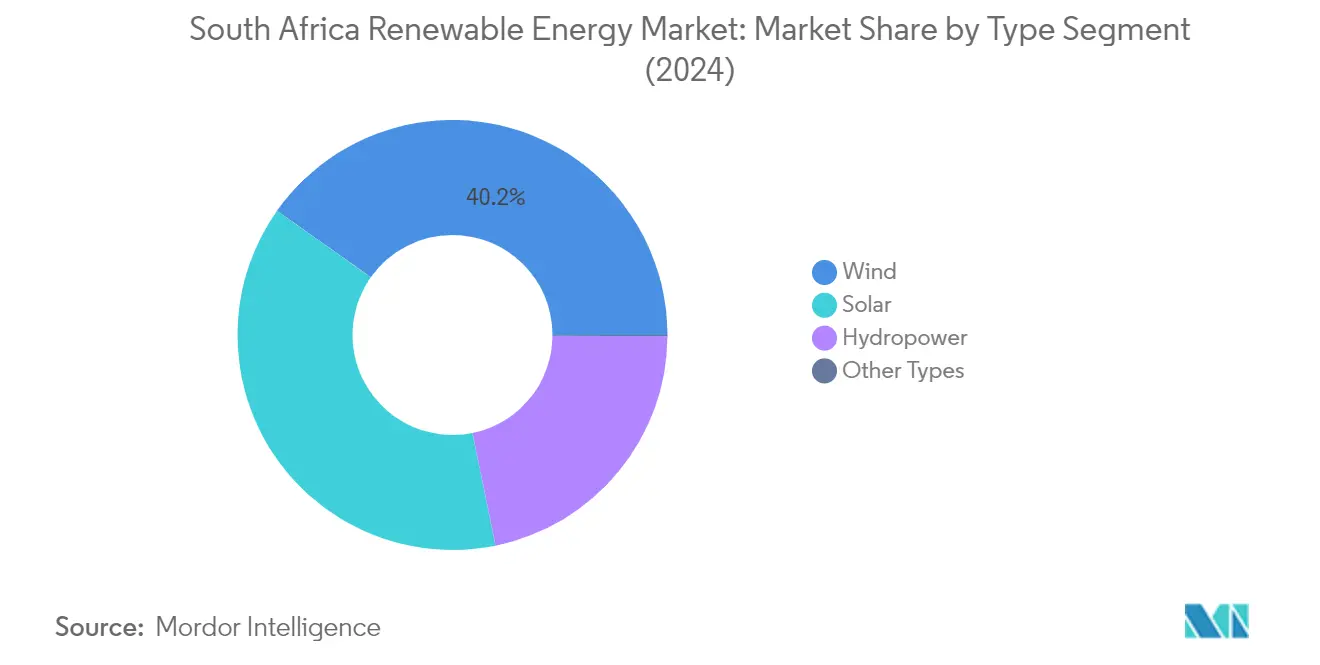South Africa Renewable Energy Market Analysis
The South Africa Renewable Energy Market size is estimated at 18.41 gigawatt in 2025, and is expected to reach 31.10 gigawatt by 2030, at a CAGR of 11.05% during the forecast period (2025-2030).
South Africa is undergoing a significant energy transition as the country moves away from its traditional coal-dependent power generation infrastructure. The state power utility, ESKOM, has announced plans to decommission between 8-12 GW of coal-fired capacity by 2030, marking a decisive shift toward renewable energy sources. This transition began with the closure of the 1 GW Komati Power Plant, which is being replaced with a renewable energy complex featuring a 500 kW agri-voltaic plant, fabrication factory, and microgrid assembly supported by 244 MWh of battery storage capacity. This transformation serves as a blueprint for the planned decommissioning of other major coal power stations, including the Grootvlei, Hendrina, and Camden facilities.
The government's commitment to renewable energy development is evidenced through its robust procurement programs and policy frameworks. In April 2022, the Department of Mineral Resources and Energy (DMRE) launched a significant tender for 2.6 GW of renewable energy capacity under the sixth round of the Renewable Energy Independent Power Producer Procurement Program (REIPPPP). The tender included 1 GW of solar PV and 1.6 GW of wind power capacity, demonstrating the government's balanced approach to diversifying its renewable energy portfolio. The fifth round of REIPPPP, concluded in October 2021, resulted in 25 successful bids, comprising 12 wind projects and 13 solar projects.
Private sector participation in South Africa's renewable energy sector has shown remarkable growth through strategic investments and partnerships. In March 2022, Tronox Holdings entered a landmark long-term power purchase agreement with SOLA Group for a 200 MW solar power project, scheduled for completion by the fourth quarter of 2023. Similarly, Red Rocket commenced commercial operations of its first wind farm with an installed capacity of 147 MW, located on the border of the Northern and Western Cape Provinces, demonstrating the private sector's confidence in the market's potential.
The development of renewable energy infrastructure faces certain geographical and technical challenges, particularly in transmission capacity. Despite the Northern Cape Province's high renewable energy potential, many developers encountered difficulties during the fifth round of REIPPPP due to transmission constraints. This has led to a strategic shift in project development, with developers increasingly targeting other provinces for utility-scale projects. This geographical diversification is expected to result in broader socio-economic benefits across different regions of the country, while also addressing the technical limitations of the current transmission infrastructure.
South Africa Renewable Energy Market Trends
Strong Government Support and Policy Framework
The South African government has demonstrated a robust commitment to growth of the renewable energy industry through comprehensive policy initiatives and financial support mechanisms. The cornerstone of this support is the Renewable Energy Independent Power Producer Procurement Programme (REIPPPP), which has successfully facilitated private sector investment in grid-connected renewable energy generation. The program's effectiveness is evidenced by its ability to attract approximately USD 13 billion in private capital by 2021 for constructing and operating 77 solar and wind facilities. Additionally, the government's energy subsidies have seen a dramatic increase, tripling since 2017 to reach USD 10.4 billion by 2020, indicating strong financial backing for renewable energy investments in South Africa.
The government's commitment is further reinforced by ambitious clean energy targets and continued program expansion. In April 2022, the Department of Mineral Resources and Energy (DMRE) launched the sixth bid window under REIPPPP, seeking proposals for 2.6 GW of new renewable generation, split between 1.6 GW of onshore wind and 1 GW of solar photovoltaic capacity. This ongoing support is aligned with South Africa's broader environmental goals, including the target to achieve net-zero emissions by 2050, demonstrating a long-term commitment to sustainable energy development. The government's comprehensive approach includes both policy frameworks and financial incentives, creating a stable and attractive environment for renewable energy market investments.
Abundant Natural Resources and Favorable Geographic Conditions
South Africa possesses exceptional natural resources that make it particularly suitable for alternative energy development, especially in solar and wind power generation. The country experiences more than 2,500 hours of sunshine annually, with average solar radiation levels ranging between 4.5 and 6.5 kWh/m2 daily. This solar potential is particularly noteworthy when compared internationally—South Africa's annual 24-hour global solar radiation average of 220 W/m2 significantly exceeds that of major developed regions, surpassing the United States (150 W/m2) and the European Union (100 W/m2), making it an ideal location for solar energy development.
The country's wind energy potential is equally impressive, with an estimated total wind power potential of 67,000 GW. This vast potential is complemented by diverse geographical conditions that support various types of renewable energy installations. The country's extensive coastline and inland regions with high wind speeds provide optimal conditions for wind farm development, while the abundant sunshine in regions like the Northern Cape Province creates ideal conditions for both photovoltaic and concentrated solar power installations. These natural advantages have already attracted significant projects, such as Amazon's 10-megawatt solar plant in the Northern Cape Province, which generates over 28,000 MWh of energy annually, demonstrating the practical viability of harnessing these resources in the green energy sector.
Energy Security and Grid Modernization Needs
South Africa's pressing need for energy security and grid modernization has become a significant driver for renewable energy trends adoption. The country's aging coal fleet and increasing pressure to reduce reliance on fossil fuels have led to strategic initiatives for power generation diversification. This is exemplified by ESKOM's comprehensive plan to decommission 8-12 GW of coal-fired capacity by 2030, starting with the closure of the 1 GW Komati Power Plant. The transition includes replacing these facilities with renewable energy for industry complexes, incorporating innovative solutions such as battery storage and micro-grid systems, setting a precedent for future power plant conversions.
The urgency for grid modernization is further emphasized by existing transmission constraints, which have influenced renewable energy trends project development patterns. These constraints have led to a strategic shift in project locations, encouraging developers to explore opportunities in various provinces beyond traditional focus areas like the Northern Cape. This diversification not only addresses grid capacity issues but also promotes broader socio-economic benefits across different regions of the country. The transformation is supported by significant private sector involvement, as demonstrated by projects like Tronox Holdings' agreement with SOLA Group for a 200 MW solar power facility, showcasing the industry's commitment to modernizing South Africa's energy infrastructure.
Segment Analysis: Type
Wind Segment in South Africa Renewable Energy Market
The wind energy segment has emerged as the dominant force in South Africa's renewable energy market, holding approximately 40% market share in 2024. This leadership position is supported by the country's substantial wind power potential, estimated at 67,000 GW. The government's strategic focus on wind energy development through initiatives like the Renewable Energy Independent Power Producer Procurement Program (REIPPPP) has been instrumental in driving this segment's growth. Major wind energy projects across various provinces, particularly in the Northern and Western Cape regions, have contributed significantly to the installed capacity. The segment's prominence is further reinforced by continued foreign direct investment and partnerships between local and international developers, demonstrating strong market confidence in South Africa's wind energy sector.
Solar Segment in South Africa Renewable Energy Market
The solar energy segment is demonstrating remarkable growth potential in the South African renewable energy sector for the period 2024-2029. This exceptional growth trajectory is driven by South Africa's abundant solar resources, with most regions receiving more than 2,500 hours of sunshine annually and solar radiation levels ranging between 4.5 and 6.5 kWh/m2 per day. The country's strategic location and climate conditions make it one of the world's premier destinations for solar energy development in South Africa. The segment's expansion is further supported by decreasing technology costs, improving efficiency of solar panels, and the government's commitment to achieving net-zero emissions by 2050. Both utility-scale solar projects and distributed solar installations are contributing to this growth, with particular emphasis on photovoltaic power and concentrated solar energy technologies. Solar energy companies in South Africa are playing a pivotal role in this expansion, leveraging technological advancements to enhance efficiency.
Remaining Segments in Type Segmentation
The hydropower and other renewable energy segments play vital complementary roles in South Africa's renewable energy landscape. Hydropower serves as a reliable baseload power source and offers the advantage of quick response to peak demand periods. The segment's development is concentrated along the eastern escarpment, where approximately 6,000 potential sites have been identified. Meanwhile, the other renewable energy types segment, which includes waste-to-energy and bioenergy projects, represents emerging opportunities in the market. These segments contribute to the diversification of South Africa's renewable energy portfolio and support the country's goal of achieving a more sustainable and resilient power generation mix. Renewable energy companies are increasingly exploring these opportunities to diversify their portfolios and enhance sustainability.
South Africa Renewable Energy Industry Overview
Top Companies in South Africa Renewable Energy Market
The South African renewable energy market features a mix of global and regional players focusing on continuous innovation and strategic expansion. Renewable energy companies in South Africa are increasingly investing in research and development to enhance their technological capabilities, particularly in solar PV and wind energy solutions. Market leaders are demonstrating operational agility through vertical integration across the value chain, from component manufacturing to project development and maintenance services. Strategic partnerships and collaborations have become crucial for market penetration and project execution, with companies forming joint ventures to leverage complementary strengths. The industry has witnessed significant expansion through greenfield projects and capacity additions, particularly under the Renewable Energy Independent Power Producer Procurement Programme (REIPPPP), while companies are also diversifying their portfolios to include emerging technologies like energy storage solutions.
Global Players Dominate Growing Regional Market
The South African renewable energy landscape is characterized by the strong presence of international conglomerates like EDF Renewables, Engie SA, Enel SpA, and Acciona Energia, who bring significant technical expertise and financial capabilities to the market. These global players have established local subsidiaries and partnerships to strengthen their market position and navigate regional requirements effectively. The market structure shows moderate consolidation, with major players controlling substantial market share through their extensive project portfolios and established relationships with key stakeholders, including government entities and local partners.
The market has witnessed active merger and acquisition activity, exemplified by strategic moves such as Engie's acquisition of Abengoa's stake in the Xina Solar One CSP plant and Serengeti Energy's acquisition of Renewable Energy Holdings. Equipment suppliers like Canadian Solar, Vestas, and JinkoSolar have also strengthened their presence through local manufacturing facilities and distribution networks. The industry continues to attract new investments and partnerships, particularly in emerging segments like utility-scale battery storage systems and offshore wind development, indicating a dynamic competitive environment. Leading renewable energy companies in South Africa are leveraging these opportunities to expand their influence.
Innovation and Localization Drive Market Success
Success in the South African renewable energy market increasingly depends on companies' ability to combine technological innovation with local content requirements and community development objectives. Market incumbents are focusing on expanding their project portfolios through participation in government procurement programs while investing in research and development to improve efficiency and reduce costs. Companies are also emphasizing the development of integrated energy solutions, including storage capabilities, to address the intermittency challenges of renewable energy and meet the growing demand for reliable power supply.
For new entrants and expanding players, success factors include establishing strong local partnerships, developing efficient supply chain networks, and demonstrating commitment to social and economic development goals. The market shows relatively low substitution risk due to strong government support for renewable energy transition and declining costs of renewable technologies. However, companies must navigate regulatory requirements, including local content rules and broad-based black economic empowerment (B-BBEE) requirements, while maintaining competitive pricing and service quality. The concentration of end-users, particularly the dominance of Eskom as the primary power purchaser, necessitates strong relationship management and compliance with power purchase agreement terms. Renewable energy independent power producer companies are particularly focused on these aspects to ensure their success in the market.
South Africa Renewable Energy Market Leaders
-
Mainstream Renewable Power Ltd
-
Segen Solar(Pty) Ltd
-
Juwi Renewable Energies (Pty) Ltd
-
EDF Renewables
-
Acciona Energia SA
- *Disclaimer: Major Players sorted in no particular order

South Africa Renewable Energy Market News
In April 2022, the Department of Mineral Resources and Energy (DMRE) launched the sixth bid window under the Renewable Energy Independent Power Producer Procurement Program (REIPPPP), seeking proposals for 2.6 GW of new renewable generation. The tender capacity is split between 1.6 GW of onshore wind and 1 GW of solar photovoltaic (PV). The bidders need to submit their bids by August 11, 2022.
In March 2022, Red Rocket announced commercial operations of its first wind farm in South Africa. The project is situated on the border of the Northern and Western Cape Provinces, South Africa. The project has an installed capacity of 147 MW and a contracted capacity of 140 MW.
South Africa Renewable Energy Market Report - Table of Contents
1. INTRODUCTION
- 1.1 Scope of the Study
- 1.2 Market Definition
- 1.3 Study Assumptions
2. EXECUTIVE SUMMARY
3. RESEARCH METHODOLOGY
4. MARKET OVERVIEW
- 4.1 Introduction
- 4.2 Renewable Energy Mix, 2021
- 4.3 Renewable Energy Installed Capacity and Forecast, in GW, till 2027
- 4.4 Recent Trends and Developments
- 4.5 Government Policies and Regulations
-
4.6 Market Dynamics
- 4.6.1 Drivers
- 4.6.2 Restraints
- 4.7 Supply Chain Analysis
- 4.8 PESTLE Analysis
5. MARKET SEGMENTATION - BY TYPE
- 5.1 Wind
- 5.2 Solar
- 5.3 Hydropower
- 5.4 Other Types
6. COMPETITIVE LANDSCAPE
- 6.1 Mergers and Acquisitions, Joint Ventures, Collaborations, and Agreements
- 6.2 Strategies Adopted by Leading Players
-
6.3 Company Profiles
- 6.3.1 EPC Developers/Operators/Owners
- 6.3.1.1 EDF Renewables
- 6.3.1.2 Acciona Energia SA
- 6.3.1.3 Juwi Renewable Energies (Pty) Ltd
- 6.3.1.4 Mainstream Renewable Power Ltd
- 6.3.1.5 Scatec ASA
- 6.3.1.6 Renewable Energy Holdings (Pty) Ltd
- 6.3.1.7 Engie SA
- 6.3.1.8 Enel SpA
- 6.3.2 Equipment Supplier
- 6.3.2.1 Hanwha Corporation
- 6.3.2.2 Canadian Solar Inc.
- 6.3.2.3 Vestas Wind Systems AS
- 6.3.2.4 JinkoSolar Holding Co. Ltd
- 6.3.2.5 Siemens Energy AG
- 6.3.2.6 Segen Solar (Pty) Ltd
- *List Not Exhaustive
7. MARKET OPPORTUNITIES AND FUTURE TRENDS
South Africa Renewable Energy Industry Segmentation
Renewable energy refers to the utilization of resources replenished by nature on a human timescale, including sunlight, wind, the movement of water, and geothermal heat. The South African renewable energy market considers the total installed capacity of renewable energy sources in South Africa, which includes new renewable energy projects such as wind, solar, etc.
The renewable energy market is segmented by type into wind, solar, hydropower, and other types. For each segment, the market sizing and forecasts have been done based on installed capacity (MW).
South Africa Renewable Energy Market Research FAQs
How big is the South Africa Renewable Energy Market?
The South Africa Renewable Energy Market size is expected to reach 18.41 gigawatt in 2025 and grow at a CAGR of 11.05% to reach 31.10 gigawatt by 2030.
What is the current South Africa Renewable Energy Market size?
In 2025, the South Africa Renewable Energy Market size is expected to reach 18.41 gigawatt.
Who are the key players in South Africa Renewable Energy Market?
Mainstream Renewable Power Ltd, Segen Solar(Pty) Ltd, Juwi Renewable Energies (Pty) Ltd, EDF Renewables and Acciona Energia SA are the major companies operating in the South Africa Renewable Energy Market.
What years does this South Africa Renewable Energy Market cover, and what was the market size in 2024?
In 2024, the South Africa Renewable Energy Market size was estimated at 16.38 gigawatt. The report covers the South Africa Renewable Energy Market historical market size for years: 2021, 2022, 2023 and 2024. The report also forecasts the South Africa Renewable Energy Market size for years: 2025, 2026, 2027, 2028, 2029 and 2030.
Our Best Selling Reports
South Africa Renewable Energy Market Research
Mordor Intelligence delivers a comprehensive analysis of the South Africa renewable energy market. We leverage extensive expertise in energy industry analysis and consulting services. Our detailed report examines the rapidly evolving renewable energy sector in South Africa. It covers major players, from solar energy companies to renewable energy IPP companies. The analysis encompasses key developments in the clean energy and green energy sectors, with a particular focus on renewable energy companies in Cape Town and other major regions. Our research methodology includes a detailed assessment of top renewable energy companies in South Africa and emerging trends in the energy industry.
The report provides stakeholders with actionable insights into renewable energy industry growth and market trends. It is available in an easy-to-read report PDF format for download. We offer a detailed analysis of solar companies in South Africa and utility companies in South Africa. Additionally, there is a comprehensive evaluation of renewable energy investments and opportunities. The report benefits investors, policymakers, and industry participants by providing detailed insights into green energy companies operations, renewable energy business opportunities, and industry dynamics. Our analysis includes an assessment of top 10 solar companies and renewable energy companies on JSE, supporting strategic decision-making in the rapidly evolving South African renewable energy landscape.





